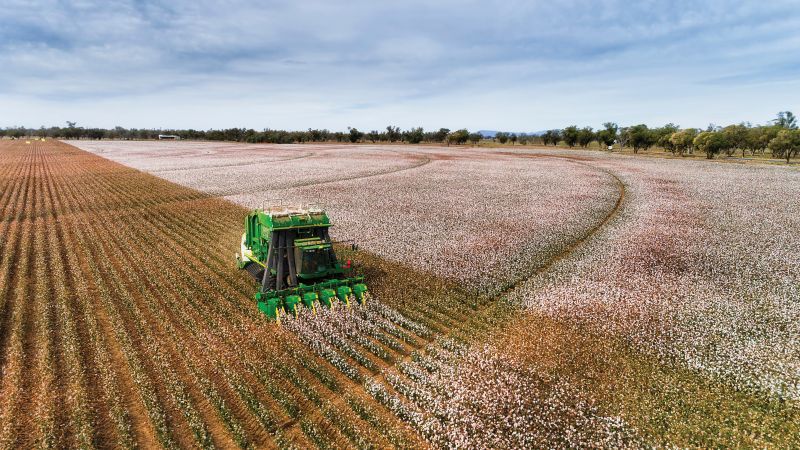Lessons from the 2011 Drought
From Cotton Grower Magazine – June/July 2016
For Southwest cotton farmers who have been around for long enough, the devastating drought of 2011 wasn’t entirely unprecedented.
In the 1950s, a similar weather phenomenon disrupted production agriculture throughout the region, and it ultimately revolutionized the way growers thought about applying water to their crops. Necessity, it seems, is the mother of invention when it comes to irrigation. Today, on the heels of a years-long drought that began in 2011, it would be safe to say that irrigation has once again been reshaped by a devastating act of Mother Nature.
“What these two time periods have in common is that people really had to make some tough decisions,” says Dana Porter, Extension irrigation specialist with Texas A&M University. “In the 1950s, they really didn’t think the water would deplete like it did. They put in wells and irrigated. Conservation wasn’t really top of their minds back then.
“Now, though, what the guys are looking at are that our well capacities have decreased, and we don’t expect that to increase any time soon,” says Porter. “So they’re recognizing that they have to be more efficient with their water. They’re already limited on capacity, so now it’s a matter of getting the most value out of the water they apply. The ‘most pop per drop’, is something we’ve all heard.”
Taking the Punch
For many Southwest producers, 2010 had been a wet year in terms of rainfall. Then 2011 presented severe drought conditions across the region. The 2012 and 2013 production seasons featured limited rainfall that failed to adequately replenish the moisture that had been sapped from the water table in 2011.
While the three-year battle against dry conditions was obviously a struggle for countless cotton producers in the Southwest, the length of the drought did serve to change the way many of them thought about irrigation. In many cases, the adaptations they made to water management techniques proved crucial.
“The drought changed their considerations on designs,” Porter says. “Growers started to go in with drip irrigation on every row, for instance, where they had only had every other row previously. Or they thought about new ways of zoning. So by dividing fields into smaller zones, I could have more flexibility in my management. If I had six zones, I had the capacity to only turn on two or three at a time. It cost a little more to put them in this way, but I had better flexibility and could adapt and be more targeted with my water applications.”
In many cases, the solutions growers have turned to over the last few years may seem rather basic. Porter points to the number of growers who took the simple step of replacing nozzles on their pivots.
“When we lose capacity in a well, we start to think about the gallons per minute we can get out to the field, and we want a uniform application. Replacing nozzles earlier rather than later would help us get a good distribution uniformity,”
says Porter.
In some areas of the Southwest, the use of a split-pivot system became more prevalent.
“We’ve been doing split-pivot watering in the South Plains for a long time, where you might have half the field in corn and half in cotton under the same pivot,” says Porter. “That lets me pair a more drought tolerant crop with a less drought tolerant crop. Or it allows me to have two different crops where their peak water-use time is different from each other, so I’m not handling a peak-watering use time for both of them at the same time.”
Watering Precisely
Throughout the region, growers brought ideas they had gleaned from other precision agriculture practices into the arena of water use efficiency. Companies like AgSmart, which offers irrigation products and services, were quick to respond.
“Growers have wells going deeper, and we know they need to conserve water,” says Brett Norman, CEO at AgSmarts. “We know farmers may be over-irrigating, they don’t know by how much, and it’s hurting both their yield and their bottom line, from a cost of production in labor and in fuel. So grower interest in what we offer has been strong.”
Based in Memphis, AgSmart manufactures sensor stations which enable producers to gather points of data from their fields that allow them make better production decisions throughout a growing season. Norman says his company’s products allow growers to monitor variables such as soil moisture, temperature, wind speed, rainfall and flows off of wells for both center pivots and power units. “All of this data comes back to one central location and helps them make better decisions,” says Norman.
That knowledge of in-field conditions has been something Southwest producers have come to rely on in the wake of recent drought conditions, according to Porter.
“My best advice going forward would be to get a real understanding of what your well capacity is, understand what your crop requirements are, understand your soil moisture and holding capacity,” says Porter. “If you really understand those things, then you can make better decisions.”










